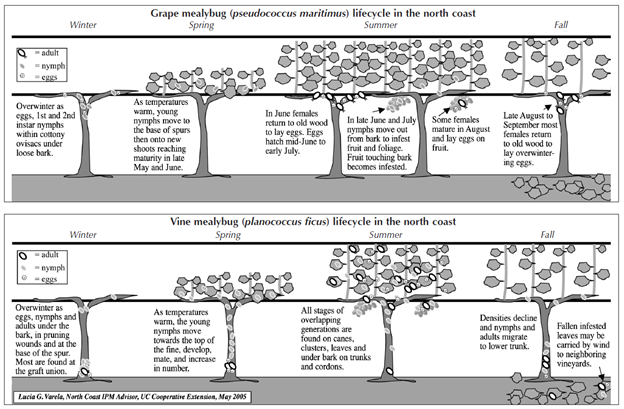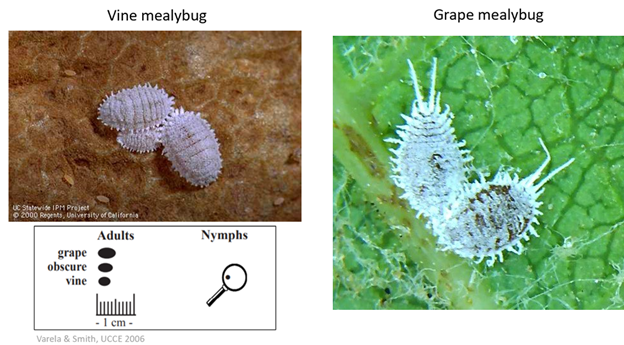


Grape growers on the West Coast have become familiar with the rising threat of vine mealybug in recent years. The insect is particularly concerning for growers as it can spread quickly and can cause permanent damage to vines by spreading leafroll viruses.
Growers should familiarize themselves with the differences between the invasive vine mealybug (VMB) and the native grape mealybug (GMB). Both types of mealybugs are present in California and can cause significant damage to vines, although IPM strategies often vary depending on species.
Mealybugs are extremely sexually dimorphic, with winged, tinier males and mostly sessile, larger, wingless females. For identification purposes, adult females are the easiest specimens to use to distinguish species. When looking for adult females for identification, thoroughly examine the vine.Mealybugs may be present on various plant parts depending on species and time of year. Bringing a hand lens can be extremely helpful in identification, as even adult females can be rather small.

Upon finding females to identify, growers can look for several visual clues to determine which species they’re dealing with. Vine mealybugs have very short, waxy, uniform filaments, including the caudal filaments. The caudal filaments on grape mealybugs are noticeably longer, and filaments on the insect overall tend to appear slightly ‘kinked’ or nonparallel. Grape mealybugs also tend to have longer, more rectangular bodies and are overall larger at maturity than vine mealybugs are.

Vine mealybug (left) vs. grape mealybug (right). Right photo taken by Haydn Lenz, Suterra.
Ostiolar fluid, a defensive mechanism used by mealybugs, is also a useful tool for distinguishing adult females of certain species. When disturbed, grape mealybugs may emit small drops of this fluid. In grape mealybugs, this fluid is a distinctive reddish-orange color. Ostiolar fluid can be a particularly helpful tool in distinguishing grape mealybug from obscure mealybug, which are very visually similar apart from their defensive fluid.
Growers can use other clues around the vineyard to determine if they are dealing with grape or vine mealybug. One of the most conspicuous clues growers can use is the presence of honeydew. Honeydew is a sticky excrement produced by mealybugs while feeding on vines. While both species of mealybug produce the substance, VMB produces drastically more honeydew overall, increasing the chances of sooty mold and ants on your vines. However, the overall amount of honeydew observed will also relate to the population density of the species present in the vineyard.
Males of the two mealybug species can also be effectively monitored through the use of pheromone-based traps and lures. These lures use the pheromone of the female insect to attract sexually mature males, trapping them and allowing growers another tool, in addition to visual scouting, to monitor pest populations by species. Suterra offers monitoring solutions for both vine and grape mealybug.
If you have questions about mealybugs, monitoring, or pheromone-based mating disruption, Suterra is happy to help. Contact your local representative or send the company an email through the online form.